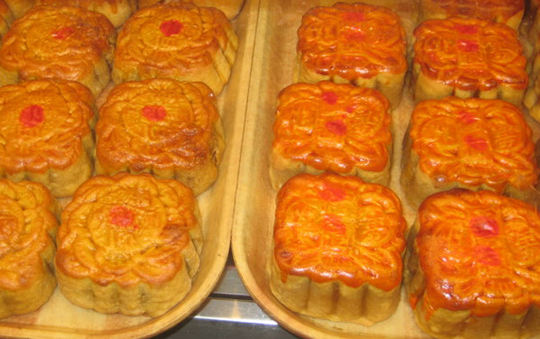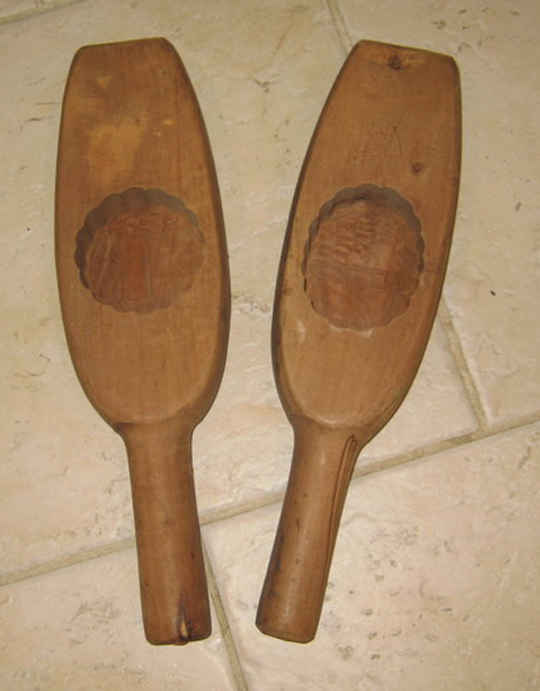
| What is Flavor and Fortune? |
| How do I subscribe? |
| How do I get past issues? |
| How do I advertise? |
| How do I contact the editor? |
Read 13100357 times
Connect me to:
| Home |
| Articles |
| Book reviews |
| Letters to the Editor |
| Newmans News and Notes |
| Recipes |
| Restaurant reviews |
| Article Index (all years, slow) |
| List of Article Years |
| Article Index (2025) |
| Article Index (last 2 years) |
| Things others say |
| Related Links |
| Log In... |
| Authors |
| Categories & Topics |
Crying for Mooncakes
| by Tanja Cilia |
Holidays and Celebrations
Winter Volume: 2008 Issue: 15(4) page(s): 8 and 9
Fion Lim, a resident of Singapore, talks to Tanja Cilia about a special festival. Enjoy the questions and answers.
IS SINGAPORE A MULTI-ETHNIC COUNTRY:
Yes, we are multi-racial and we practice several different religions here, in fact, we even have public holidays for many of them. In Singapore, at least, there is Vesak Day for the Buddhists, Good Friday for the Christians, Hari Raya Haji for Muslims, and Deepavali for the Hindus; and there are others including holidays for the New Year for the four major ethnic groups. Mooncake Festival is not a public holiday in Singapore, but it is a major Chinese festival with much celebrating.
WHEN IS THE MOONCAKE FESTIVAL CELEBRATED:
This is not a moveable feast. Called Chung Chiu, this Moon Festival always occurs on the fifteenth day of the eighth month of the Chinese Lunar Calendar. The date for this year and the next few are:
2008: September 14th
2009: October 3rd
2020: September 22nd
2011: September 12th
2012: September 30th
2013: September 19th
2014: September 8th
2015: September 27th
IS THERE A CORRESPONDING WESTERN CELEBRATION:
One might say it is similar to a harvest festival or Thanksgiving. In Hong Kong it is celebrated simultaneously with the Lantern Festival. However, strictly speaking, it is not an agrarian rejoicing about gathering the harvest. It is more of a spiritual event. The Mooncake Festival celebrates the fundamental tenet of Taoism; the union of man's spirit with nature. Mooncakes, called yue bing, in Chinese, take their name from their shape. Traditionally, they are stuffed with lotus seed paste, duck eggs, and ground sesame seeds.
One story traces the origins of this festival food back to the fourteenth century, when China was in revolt against the Mongol Empire who ruled them during the Yuan Dynasty (1280 - 1368 CE). It was then that Chy Yuen-chang and his senior deputy, Liu Po-wen, concocted a plan wherein the latter would dress up as a Taoist priest and take cakes to the people in the besieged city, ostensibly to bless the longevity of the Mongol Emperor. On the day of the festival as people would begin to eat the cakes, they found instructions on how to coordinate a midnight massacre of the Tartars. Doing so led to the establishment of the Ming Dynasty (1368 - 1644 CE).
HAS THE RECIPE REMAINED THE SAME SINCE THEN:
Modern mooncakes have dozens of different fillings, savory as well as sweet. Some have nuts and ham, melon seeds and almonds, adzuki paste, green bean paste, fruit and orange peel, or even a coffee-flavored filling. Tai Pan's Snowy Mooncake is made with piecrust pastry. It is very different from those traditionally baked with their slightly crumbly pastries. There are also Snow Skin Mooncakes and called bing pei. There is a Southeast Asian variation made with cooked glutinous rice flour and Haagen-Dazs ice-cream.
 Usually, a golden yolk from a salted duck egg is placed at the center of each Mooncake. More elaborate versions have four yolks to represent the four phases of the moon. Traditionally, thirteen mooncakes are piled in a pyramid, as a symbol of the thirteen moons of a complete year representing the twelve moons, one for each month plus an intercalary month. There are calorie-controlled versions of mooncakes these days, too.
Usually, a golden yolk from a salted duck egg is placed at the center of each Mooncake. More elaborate versions have four yolks to represent the four phases of the moon. Traditionally, thirteen mooncakes are piled in a pyramid, as a symbol of the thirteen moons of a complete year representing the twelve moons, one for each month plus an intercalary month. There are calorie-controlled versions of mooncakes these days, too.
HOW AND WHY IS THE MOON IMPORTANT:
People congregate on a plateaux or on mountains to look at the full moon, which that night is at its fullest and brightest. They hope wishes they make will be granted and they take traditional lanterns with them to light the way. These are made in the shapes of lobsters, butterflies, rabbits, goldfish, carp, and star-fruit; these days many are made of plastic and are even battery-powered. There was a time when only paper lanterns with candles were used. Sometimes, riddles are written on lanterns for people to solve. This traditional game is called deng mi.
In some places, people burn incense sticks or plant Mid-Autumn trees, or have fire-dragon dances. Korean names for this festival are Chuseok and Hangawi. The latter is from han which means great and gawi meaning middle. Together they mean 'a great day in the middle of the autumn.' An eclipse of the moon would be an awful celestial happening; they would think the Heavenly Dog would be trying to swallow the Moon. Therefore, they beat gongs and drums to scare him away.
CAN YOU SHARE A CHINESE LEGEND ABOUT THE MAN IN THE MOON:
There is one about the Man and the Lady on the Moon. She is Chang-O, a beautiful woman who lived during the Hsia Dynasty (2205 - 1766 BCE). She was the wife of the Chief Archer of the Imperial Guard, General Hou-Yi. The story told is that the Jade Emperor had ten sons, each taking turns to shed light and heat on earth. One day, they inexplicably appeared together, and Hou-Yi was going to shoot them all down with his red bow and white arrows. However, he only killed nine of them. Why nine? Because his wife begged him to allow one sun to stay to heat the Earth at night. The Queen Mother of the West made this son immortal, lest the other suns appear again. If they did, he would be able to shoot them down each time so rivers would not run dry and people would not die.
The feminist version of this story says that Chang-O shot down the suns but chose to flee to the moon with the Herb of Immortality. Another legend says she stole that from her husband who was a tyrant. On the moon, she met the friendly Jade Rabbit and still lives there with Wu Gang, the Tree Cutter who cooks and brews wines for her. When he cuts trees, we can see the moon's bright light. Wu Gang was sent there as punishment and can only return when he cuts down the cassia tree. This is impossible since the tree is immortal and grows back whenever he stops hewing at it.
WHERE DOES JACK RABBIT COME IN:
One story tells of three mystics who disguised themselves as three old men. They begged for something to eat from a fox, a monkey, and a rabbit. The first two did have something to give. But the rabbit, not having anything, jumped into a blazing fire to roast himself. The gurus were impressed, and so touched by the rabbit's sacrifice that they allowed him to live with Chang-O forever in her crystal palace. Actually, there are many variations of the above legends. Perhaps you know a different one.
WHAT ARE THE IDEOGRAPGHS AND PICTURES ON MOONCAKES AND ON THESE HOLIDAY BOXES:
Chang-O, with her flowing robes and Jade Rabbit are sometimes there for all to see and remember. During the Qing Dynasty (1644 - 1911 CE), Mooncakes were renamed 'Moon Flowers' because in Mandarin the word yue bing for Mooncakes sounds like 'monthly sickness' (menstruation). It is said that if you point at the moon during this time, your ears will fall off and your fingers become crooked.
WHO IS THE MAN IN THE MOON:
Yueh Lao Yeh or Yue Xia Lao Ren is the matchmaker who prepares marriages on the Moon. He writes down names of couples on his tablets, knows everyone's future partner, and has a register with the names of all newborns in it.
WHICH FAMILY TRADITIONS ARE CONNECTED WITH THIS FESTIVAL:
This is a time for family reunions when its member are to reunite from the four corners of the world, if possible, and eat Mooncakes together. If anyone cannot attend, they are to all look at the moon from wherever they are and think of their loved ones. The idea is to catch the moon's reflection in the center of their teacup. This is also a time for gift-giving. Chinese people do so for most festivals; for this one they give a box of Mooncakes to the family of each of their relatives. The more egg yolk they contain, the more esteem in which they hold them. Gifts can be augmented with star fruit, or sausages, even money. Chinese from Viet Nam make square Mooncakes rather than round ones; and they cut them diagonally into four pieces before eating them.
 This holiday can be an expensive exercise. Many place orders beforehand and pay the baker or bakery in instalments until the gifts are delivered. This can have added value in the way of other edibles thrown in with thanks from the bakery. One can extend the Moon Festival adding 'Moon Welcoming' which is the day before and 'Moon Chasing' which is the day afterwards. During the time of The Empress Dowager Ci Xi, moon festivities lasted from the thirteenth through the seventeenth day of the eighth lunar month.
This holiday can be an expensive exercise. Many place orders beforehand and pay the baker or bakery in instalments until the gifts are delivered. This can have added value in the way of other edibles thrown in with thanks from the bakery. One can extend the Moon Festival adding 'Moon Welcoming' which is the day before and 'Moon Chasing' which is the day afterwards. During the time of The Empress Dowager Ci Xi, moon festivities lasted from the thirteenth through the seventeenth day of the eighth lunar month.
WHICH SPECIAL FOODS GO LONG WITH MOONCAKES:
We chai (yams) and melons, pomegranates and dates, peanuts and fatt koh (steamed sponge cakes) are said to be special to Chang-O. All round fruits are reminiscent of the moon and are said to bring peace and unity. Women traditionally peel pomelos and mini yams and cut them so that the moon sees them doing this. They do this hoping that when seen, they will be rewarded by having a flawless complexion. The word for pomelo in Cantonese is yow which is the same as for the word 'have.'
Food offerings for ancestors are placed on a table-altar, and are usually grapes, apples, pears, peaches, pomegranates, melons, water chestnuts, oranges and grapefruits. There also might be edible land snails. Cooked taro is essential, because one legend says it was the first food discovered on the night of creation.
_____
Tanja Cilia is an Allied Newspapers (Malta) columnist. This edited article appeared in the Times of Malta, where she lives. Fion Lim, her friend, lives in Singapore. The Chinese she spells out in the article is mostly Cantonese, though some words are provided in other languages, as appropriate.

Copyright © 1994-2025 by ISACC, all rights reserved
Address
3 Jefferson Ferry Drive
S. Setauket NY 11720